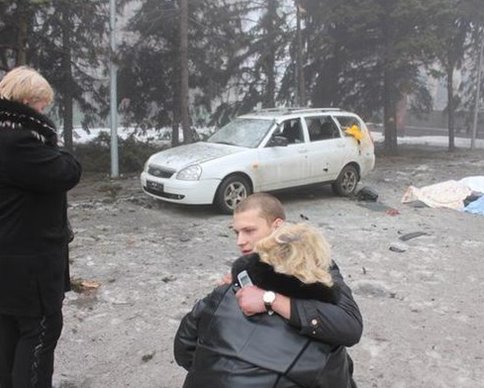Yesterday’s live coverage of the Ukraine conflict can be found here. An archive of our liveblogs can be found here. For an overview and analysis of this developing story see our latest podcast.
Please help The Interpreter to continue providing this valuable information service by making a donation towards our costs.
For links to individual updates click on the timestamps.
For the latest summary of evidence surrounding the shooting down of flight MH17 see our separate article: Evidence Review: Who Shot Down MH17?
Eastern Ukraine has been reeling this week from an escalation of Russia’s war. As in past months, there was an infusion of new convoys of T-72B tanks from Russia, and other armor not seen before such as the Smerch, the Pion and and possibly an advanced ground radar system which could only have come from Russia, geolocated to Makeyevka, a town to the east of Donetsk.
CNN’s Nick Paton Walsh learned from a diplomat that 67 civilians died in the war just this week. As we know, of these, 30 alone were in Mariupol in the Grad missile fire last weekend.
A blogger named @666_mancer has tried to document the locations of all reported shellings in Donetsk in recent months, as the devastation for people has been great.
Translation: Information about 22-23 shellings #Donetsk on 30/01/15 #DNShellReport #Russianukrainianwar
He believes that while each incident requires investigation, and both sides have at different times been responsible for firing on civilian areas, many of the recent shellings are the responsibility of the Russian-backed separatists as they control the city. They have taken over the Donetsk Airport and are pushing outward from the areas around it. It becomes harder to invoke the excuse that wayward shells come from the airport when the Ukrainian forces are no longer there, although they maintain positions in Avdeyevka, under attack from separatists.
The self-proclaimed “Donetsk People’s Republic” blame all shelling incidents routinely on the Ukrainians, as they did today. Yet they describe an arrest their own fighters made of three Russian Federation citizens who were caught randomly firing mortars in the city.
The total civilians killed today was reported as 12:
CNN reported this figure but noted that their reporter could not verify all the deaths; 7 were confirmed.
We also found that ultimately only 7 persons killed could be confirmed — 5 in one incident where a shell hit the parking lot of the Hotel Europa, and 2 at a trolleybus stop.
Initial reports were confusing and made it seem as if there were two locations, but in fact the Hotel Europa is right next to the Kuybyshev House of Culture on 86 Panfilova Street. So reports of the “bombing of a cultural center” are reference to this impact. A line of people were waiting by the office of Pomozhem (We’ll Help), a charity run by oligarch Rinat Akhmetov, and were mainly picking up bread.
As the foundation’s director explained in a statement, it is not that this bread line itself was hit — no one in the line was hurt. What happened was that when some of the people who had already received their loaves headed back to their parked cars by the hotel, they were struck and killed by several rockets. One man died in his car and four were hit as they approached their car.
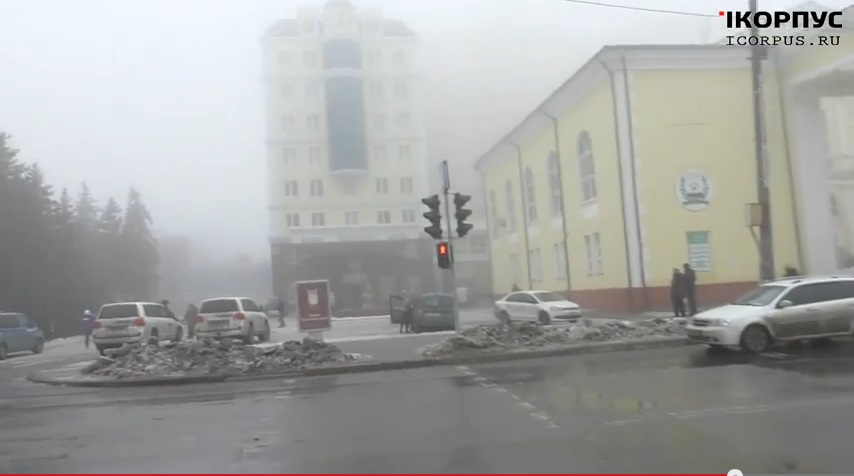
Screen grab from video. Hotel Europe (L) and House of Culture (R)
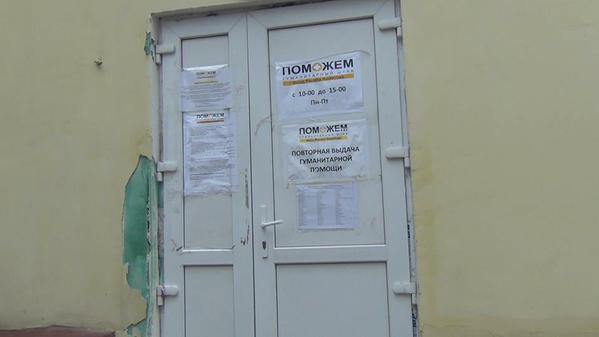
The door of the Pomozhem office, which gives the hours for when humanitarian assistance is available. Screen grab from video.
Russia’s Investigative Committee has launched a criminal investigation into the shelling near the Hotel Europe, committee spokesman Vladimir Markin told TASS. On the basis of the preliminary data, the “involvement of Ukrainian troops and the National Guard” are being checked first, he said. The Ukrainian government issued a denial that they fired on the city of Donetsk today.
As with other investigations that Russia has opened, such as the shelling of School No. 63 in Donetsk last fall, it is not clear on what grounds Russia believes it has any jurisdiction to investigate alleged crimes in a neighboring country, in incidents that do not even involve its own citizens. But Russia has evidently been compiling a larger suit to make the claim of “genocide” of the Russian people in Ukraine, a claim that no world body takes seriously.
Meanwhile, it has become more and more difficult to document civilian deaths as the war intensifies and becomes more unsafe for journalists and human rights monitors.
And there is concern that the the “Donetsk People’s Republic” may be inflating the numbers. BBC reporter Stephen Ennis published a report about concerns regarding the numbers of people killed in the shelling of a bus on Leninsky St. in Donetsk last week.
He found discrepancies in state TV accounts that appear to make the numbers higher than journalists on the scene saw with their own eyes, and also found a man claiming to be the relative of a victim — whose body was nowhere in evidence, despite graphic coverage of the scene. TV1 has been caught using fake victims before, such as the woman who recounted a version of events of the Volnovakha bus shelling that differed from others — her name was not even in the list of injured. Ennis believed some effort may have been made to make the numbers equal to the number of those killed at Volnovakha — 13. And at any rate, the drama was played up for maximum war propaganda effect on state TV.
Regardless of what the numbers are, for those who have already lost family members and wait in fear of the next shelling, the suffering is inestimable. Yet peace talks were cancelled today and their re-start is uncertain.
— Catherine A. Fitzpatrick
The vehicle looks similar to the 1RL232, a battlefield surveillance radar system designed to improve artillery fire, which is mounted on an MT-LB chassis. Here’s a picture of the 1RL232 which was seen by multiple journalists in Torez in November, discussed at length in this article published by The Interpreter in Foreign Policy:
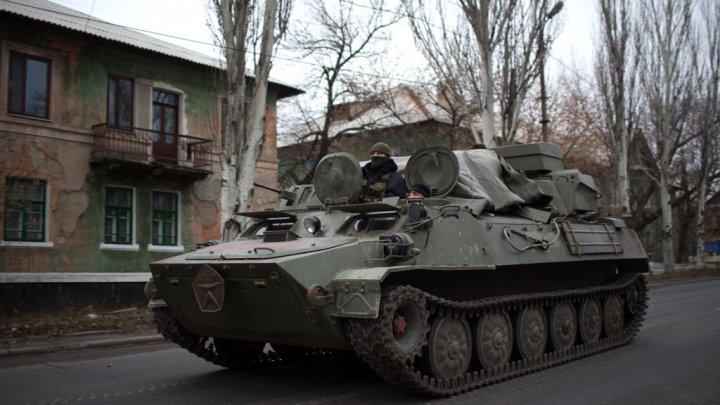
That weapons system was spotted along with a 1RL239 “Lynx” which is not used by Ukraine’s armed forces at all. As we explained then, the weapons were both new to the battlefield and would give the Russian-backed forces a significant boost:
Military experts tell us that these vehicles are potent additions to the arsenal of the Russian-backed separatists. These armored and weaponized radar systems are meant to operate just behind front lines to track the movement of enemy convoys, troops, incoming artillery fire, and even low-flying aircraft (helicopters or drones). They also act as a precision targeting system, meaning that Russian-backed fighters will be able to transform crude artillery and Grad rockets into more devastating munitions, while simultaneously granting those fighters a better a tactical assessment of the battlefield beyond their line of sight. In fact, the 1RL232 is capable of detecting targets in the air, land, and sea that are up to 40 kilometers away.
This ground surveillance radar is made even more effective when it is paired with advanced anti-aircraft weapons like the Buk system, a highly sophisticated long-range anti-aircraft weapon that almost certainly shot down Malaysia Airlines Flight MH17 last July, or the Strela-10, a short-range armored anti-aircraft system, which the Russian-backed separatists have had since late June or early July.
This time, however, we can’t make a positive identification of the vehicle in question. Many vehicles use an MT-LB chassis, and most of those vehicles are far less powerful or significant than the “Leopard.”
— James Miller
Earlier we reported that most of Uglegorsk (Vuhlehirsk in Ukrainian) had been captured by Russian-supported forces. The fall of the town, just west of Debaltsevo, puts Ukrainian forces in the “Debaltsevo Kettle” closer to being cut off and completely surrounded.
Online Magazine spotted this piece of armor in the town today on a video from the Russian news agency LifeNews, which has close ties to the Kremlin’s security apparatus (and, not coincidentally, the separatists as well).
That’s a T-72B, a tank which is only being used by the Russian-supported forces (a picture from Wikipedia for reference):

This video from LifeNews shows the Prizrak (Ghost) moving into the city, a unit which is commanded by Aleksei Mozgovoi, a Lugansk native. The fact that he is leading this campaign indicates he has not been sidelined, despite rumors this summer that the leadership of the “Lugansk People’s Republic” wanted to remove him because he challenged them on several issues, notably regarding plans for the unification of all the independent battalions under one “Novorossiya Armed Forces.” The Jamestown Foundation describes him:
Mozgovoy, a Luhansk native, was a non-commissioned officer in the Ukrainian army, then a guest worker in Russia, joined the pro-Russia rebellion in Luhansk from the outset in April 2014, and built up the Prizrak unit from the platoon to the “brigade” level. Politically, however, he has opposed the “LPR” leadership under both “presidents,” Valery Bolotov and Igor Plotnitsky.
Mozgovoy is considerably more articulate than the other field commanders (or the Luhansk leaders for that matter) and is also the most radical politically. He can hold his own in dialogues with Russian ultranationalist intellectuals on their websites. At one level, Mozgovoy shares the other Luhansk field commanders’ views: disavowing the Minsk armistice agreements, contesting the “LPR’s” legitimacy and that of Luhansk leaders, insisting on the preservation of autonomous armed formations, continuing the fight for Novorossiya. He is the prime advocate of creating a council of field commanders to either replace or duplicate the Luhansk-based authorities.
Beyond war-related issues, Mozgovoy seems to position himself as a social radical of a nationalist-expansionist bent. He calls for removing the “political-financial-oligarchic corrupt authorities” and replacing those with “real people’s power,” nationalization of privately-owned industries, and abolishing elections for the duration of the ongoing war—all of this in the spirit of “Russianness” (Russkost’, not further explained). On that basis Mozgovoy would “liberate the people” of the Luhansk and Donetsk “republics,” of Novorossiya, of Kyiv and Ukraine as a whole, apparently in that order and not necessarily ending there (Novaya Gazeta, November 21, 2014; Luhansk Information Center, December 20, 24, 2014; Novosti Novorossii, December 29, 2014; January 3, 10, 11, 2015).
At one point Mozgovoi tells the cameras (translated by The Interpreter):
“As I’ve said repeatedly, we are killing each other instead of punishing those who should be punished. We are fighting, the other side is against the oligarchs, this side is, but for some reason, we kill each other, ourselves. That is, we’re committing systematic suicide.”
As you can see from many of the tweets which show screenshots from
LifeNews footage, there is speculation that Russian special forces
(airborne Spetznaz) are taking direct control of the assault:
Ukrainska Pravda reports that Volodymyr Polevoy, deputy head of the information analysis centre at the National Security and Defence Council (NSDC) of Ukraine, has denied Ukrainian responsibility for the shelling attacks in Donetsk today that have left 11 civilians dead.
Polevoy said (translated by The Interpreter):
“The Ukrainian army has not carried out active combat operations in the Donetsk area today. The targets of the ATO forces are the militants and their positions outside urban areas.”
Polevoy claimed that the incidents were provocations that the Russians or separatists intended to use to disrupt the planned contact group talks.
He also referred to a report from the strelkov_info VKontakte page, that the ‘Donetsk People’s Republic’ authorities had arrested three Russian citizens who had been moving around by car and firing shells into the city with a mortar.
The announcement on the pro-separatist site, often used in the past to disseminate news from separatist military sources (originally Igor Girkin, aka. Strelkov, hence the url), claimed that two of the arrested individuals were from the Russian city of Krasndodar, the other from the surrounding Krasnodar Krai region.
— Pierre Vaux
Russia is regularly accused of sending weapons and ammunition into Ukraine. The Interpreter has all-but-proven that many pieces of equipment seen in the fight in eastern Ukraine must have come from the Russian military. Last November the arms experts at Armament Research Group (ARES) released the most comprehensive report (100+ pages) documenting probable Russian weapons in Ukraine.
That report is already out of date, as we have documented the introduction of the BPM-97 fighting vehicle which is only used by Russian border guards, and the GAZ Vodnik armored vehicles in the last several months.
Regardless, Russia is now raising alarm about Bosnia and Herzegovina’s plan to sell ammunition to Ukraine. DW reports:
Russian Foreign Ministry spokesmen Alexander Lukashevich said on Thursday that the Kyiv authorities would use the ammunition “to keep killing peaceful citizens,” saying that Moscow was “bewildered” by such plans:
“Such a step, especially in the current escalation on fighting in southeast Ukraine, would not contribute to peaceful resolution in the area, and would lead to new, senseless casualties among the civilian population.”
The companies Igman and Unis have agreed to deliver small arms ammunition to Ukraine, with a price tag of 4.9 million euros ($5.6 million), Bosnian media reported.
Last week Bosnia’s foreign minister resigned in protest against the deal.
— James Miller
Earlier we reported that peace talks in Minsk may be postponed. RFE/RL has confirmed this news.
Pro-Russian separatists in eastern Ukraine say peace talks due to take place in Minsk on January 30 have been postponed.
Denis Pushilin, who represents rebels holding territory in Ukraine’s Donetsk region, said he and Luhansk separatist official Vladislav Deinego would leave Minsk for Moscow…
Pushilin said the Russian-backed separatists would agree to a cease-fire with Ukrainian forces based on the current line of contact between the two sides.
— James Miller
A video uploaded yesterday evening to YouTube shows two 2S7 Pion 203 mm self-propelled guns on the move through separatist-held Makeyevka, east of Donetsk.
The location was reported to be here, in the north of the town:
If we go to this location on Yandex Maps, we can see the following on their Panorama view:

A Panoramio photo taken from a different angle shows the same building more recently, during the current conflict:

The colour scheme and signs on the shop appear to have changed, and what appears to be bottoms of the Cyrillic letters “ОДУКТЫ” is visible.
Now compare with this frame from the video:
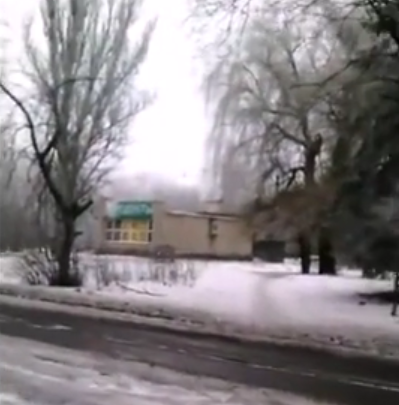
The number and arrangement of the window panes matches, as does the colour scheme. Furthermore, while blurry, the text on the sign appears to read “ПРОДУКТЫ” (groceries), which would match the text visible in the Panoramio photos.
The position of the large apartment block to the east and behind the shop also matches:
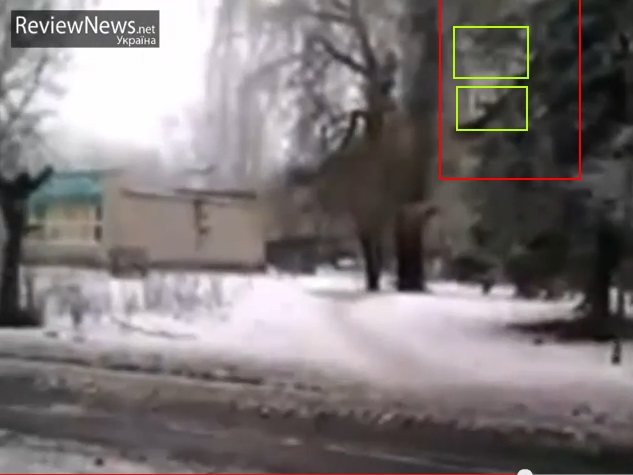
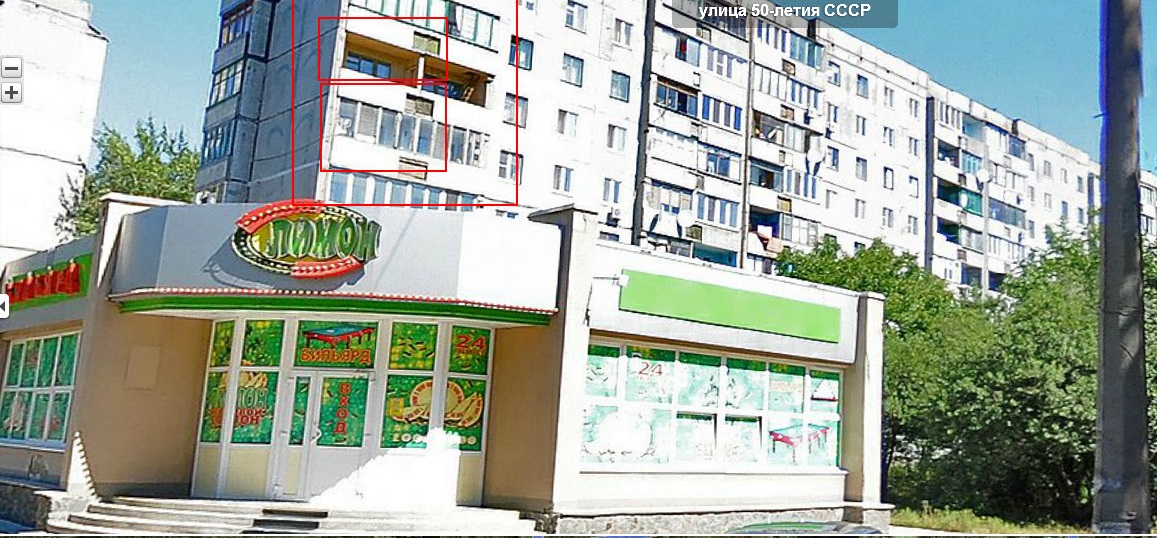
The presence of such high-calibre artillery in the hands of Russian-backed forces has not been verified by video or photographic evidence before.
Back on August 22 last year, Russia’s Rossiyskaya Gazeta, a government mouthpiece, ran a story claiming that four 2S7 Pions had been captured by separatist fighters commanded by Igor Bezler, also known as Bes (daemon), who was the military leader of forces near Gorlovka.
Such reports of captured “trophy” hardware were common at the time and we suspect that many were in fact disinformation, intended to provide plausible deniability to the presence of such weapons in separatist hands, supplied by Russia.
— Pierre Vaux and Catherine A. Fitzpatrick
There are reports now of at least nine people killed by shell fire as they waited in a line for humanitarian aid in Donetsk, in addition to at least two killed in earlier shelling today.
As is always the case in these atrocities, there is immediately a debate about whether the Russian-backed forces or Ukrainian forces are responsible for the shelling.
One woman in Kuybyshevsky District in Donetsk [Warning: Graphic] was said to be killed just as she had taken a loaf of bread, which fell at her feet.
Kuybyshevsky District has been repeatedly shelled throughout the war.
Often pro-Russian sources would say that because Ukrainian troops were firing at rebels from the airport, they were hitting civilian areas.
But now that the Ukrainian “Cyborgs” as the men defending the airport were known have been driven out, it has become far more difficult to assign blame so easily.
Podrobnosti.ua says that there has been heavy shelling of various ends of the city:
The Interpreter translates:
Shelling that hit Kubyshevsky district has exploded on Trudovykh Rezervov Street.
The 14th line trolleybus has been hit, and passengers and the driver have been injured. There are two dead according to preliminary reports.
At Politboytsov Street in the Kievsky District, a consumer gas line has caught fire near a dormitory. Glass has blown out in nearby windows.
A shell has hit the corner of Poligraficheskaya Street and Kievsky Avenue. The Hotel Evropa has been hit.
Podrobnosti.ua also had the story about the humanitarian aid line, and the implication here is that shelling came from Ukrainian positions in Avdeyevka:
At a line of people waiting to receive humanitarian aid on
Panfilova Avenue near the House of Culture in Kuybyshevsky District, 86
shells hit the area.The mortar landed next to a public transport stop where there were a lot of people.
As a result of the shelling at least 5 people died.
“Mortars from the outskirts are hitting the center. There is an impact in the line for humanitarian aid,” say local residents.
City
residents on social media are giving other figures for those dead and
wounded, reportedly 9 killed and more than 20 wounded.
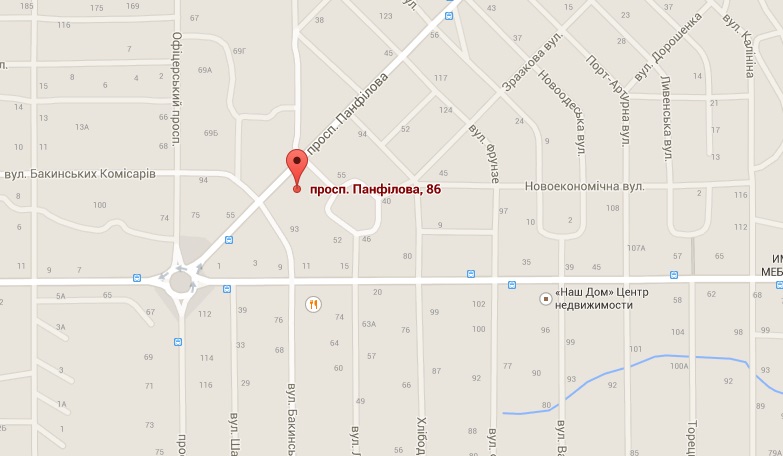
Photo by Podrobnosti.ua
Translation: In Donetsk, a trollebyus and the House of Culture have fallen under massive shelling, there are people killed. The Ukrainian Armed Forces again.
— Catherine A. Fitzpatrick
There shouldn’t be any doubt by now that Russian tanks are in Ukraine, but as questioning persists, we will continue to supply evidence.
David Weber posted a video uploaded January 28 by ActionTube showing what appear to be Russian tanks on the streets of Donetsk
The blogger @666_mancer helped to recognize the street:
The precise location is here on Google Maps and here on Google Street View.
The door has been painted a different color (green) in the time since the Google Street View photo was taken (2011) but the other elements of the scene match:
At 1:44 in the video:
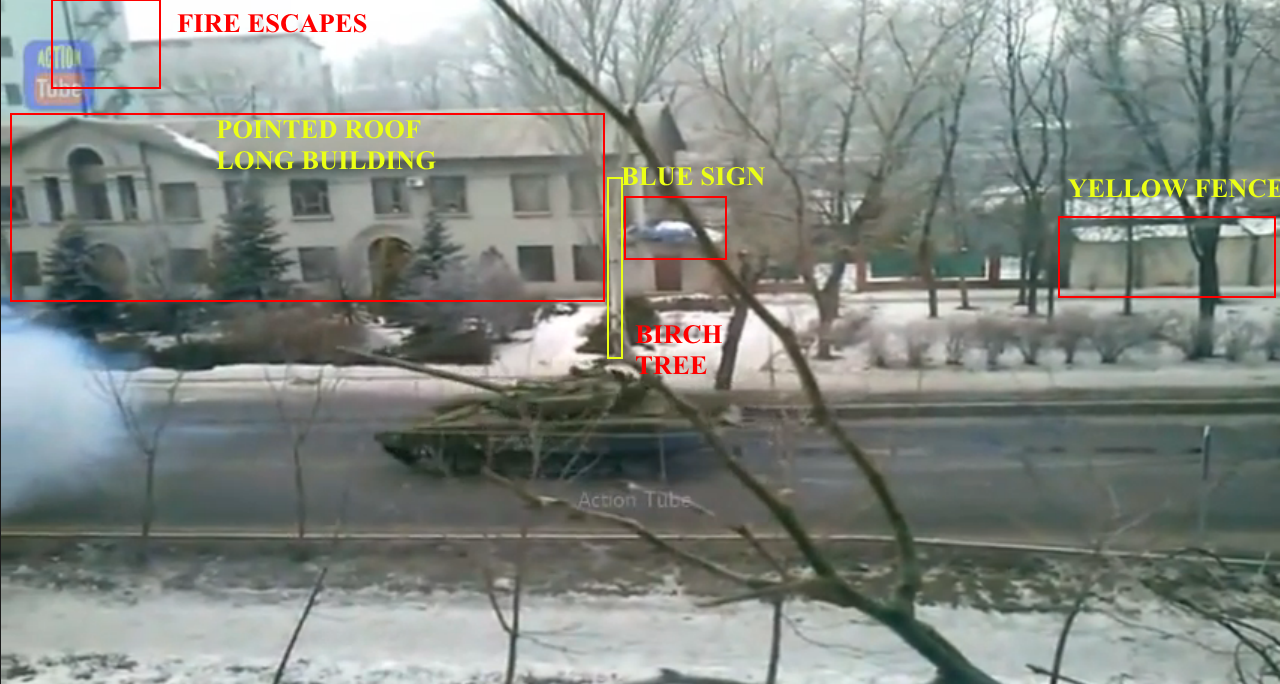
Google Street View:
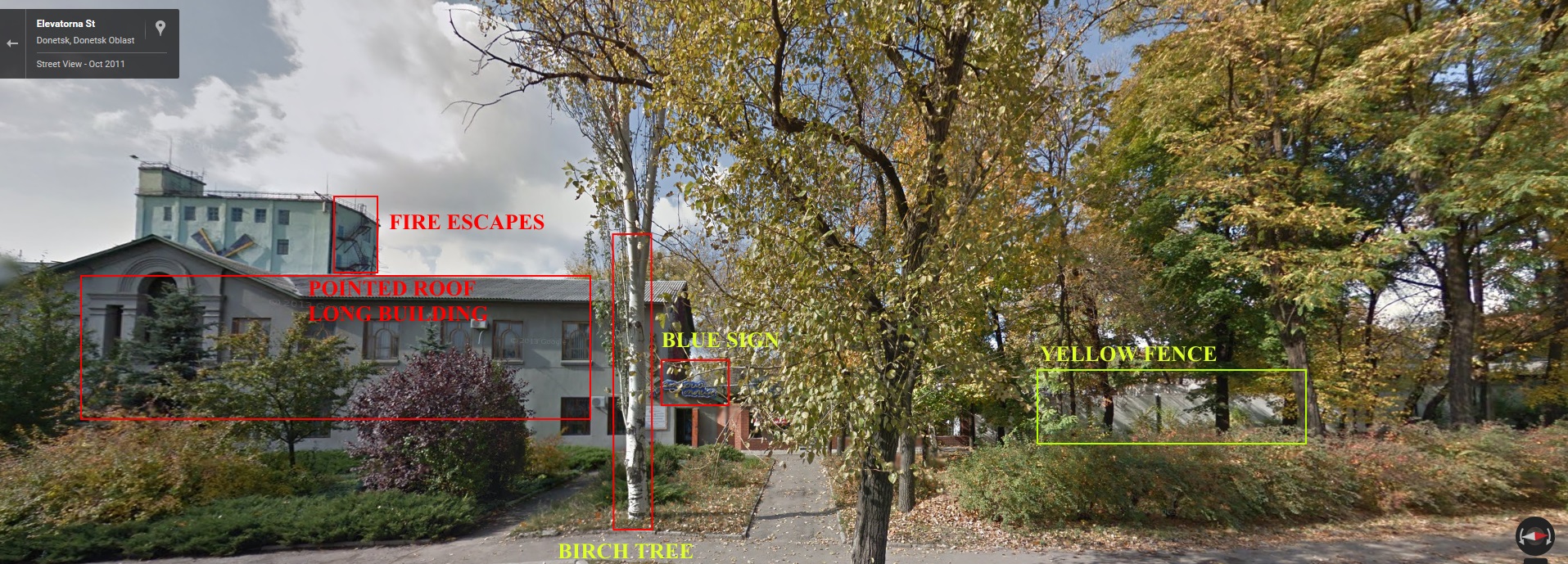
The tanks appear to be one of the modernised variants of the T-72B series, such as the BA, BM as indicated by David Weber, similar to the tank we geolocated last summer in Sverdlovsk, Ukraine which Joseph Dempsey of the International Institute for Strategic Studies also confirmed was a T-72BM, and also a convoy in September in the Lugansk Region.
The reason we believe these to be modernised BA-BM series tanks is the presence of the distinctive Kontakt-5 explosive reactive armour on the turrets.
The modernized T-72BM is only available from Russia and is not in Ukrainian stocks:

— Catherine A. Fitzpatrick and Pierre Vaux
The Minsk talks to negotiate peace in Ukraine appear to have been postponed today, the Belarusian news site Charter97.org reported, citing Belapan.
BelaPan reports that journalists arrived at the National Airport in Minsk where they had been informed that representatives of the self-proclaimed Donetsk and Lugansk People’s Republics would be arriving at 13:40
But Valery Efimenko, an aide to the airport’s general director said that the DNR and LNR representatives had already arrived in Minsk the day before, and were planning to leave Minsk at 14:30 today.
Dmitry Mironchik, the Belarusian Foreign Ministry’s press secretary said yesterday that the contact group would meet in Minsk today, January 30.
Kiev has also expressed some doubts that the meeting will take place today.
Translation: The meeting of the contact group on Donbass, planned for today, is in doubt – Ukraine Foreign Ministry.
— Catherine A. Fitzpatrick
Writing on his Facebook page, Donbass Battalion Commander Semyon Semyonchenko wrote (translated by The Interpreter):
Uglegorsk is partially under the control of the terrorists. Certain defensive points of ours are being maintained. The terrorist attack took place yesterday. After an artillery bombardment, the ATO forces’ positions were struck by tanks. Over the course of several weeks, terrorist units infiltrated the town under the guise of civilians and they struck from the rear. Enemy armoured vehicles are in Uglegorsk and sniper nests have been set up in residential buildings – the town is being fortified rapidly.
Roman Burko, a Ukrainian journalist who runs InformNapalm.org, described a similar situation, based on reports from his sources, on his Facebook page (translated by The Interpreter):
Illegal armed groups mounted strikes from the directions of Kayutovo and Yenakievo, the enemy entered Uglegorsk and pushed the ATO forces back to the railway station (there is no discussion of the complete surrender of the town).
The National Guard units were disorientated. The 13th motorised infantry battalion (from Chernihiv) and the 25th battalion are holding out. There are other units fighting too.
Defensive positions are also holding up against the charge of the militants who are pouring in. Close combat and shoot-outs are under way.
Russia’s state-owned Rossiya-24 news channel carried a report this morning that the town had fallen to the forces of the self-proclaimed “Donetsk People’s Republic” (DNR). The report showed footage of troops, tanks and armoured personnel carriers moving in the town. The prime minister of the DNR, Aleksandr Zakharchenko, was interviewed on the scene.
As @Conflict_Report pointed out on Twitter, the location filmed in the report can be geolocated in Uglegorsk:
This burning building:
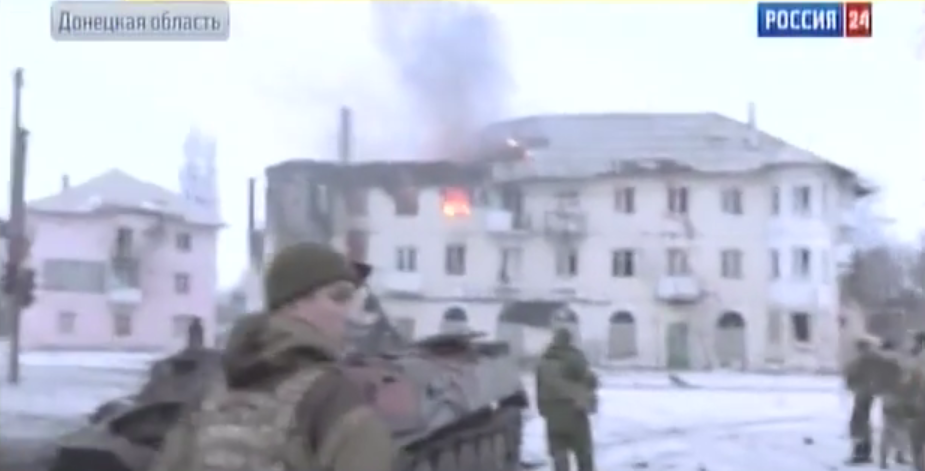
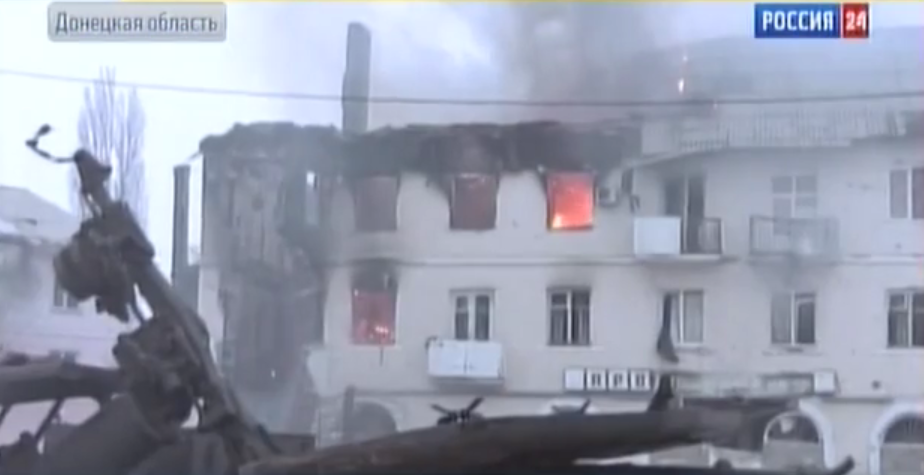
Can be found here on Panoramio:

Placing it here:
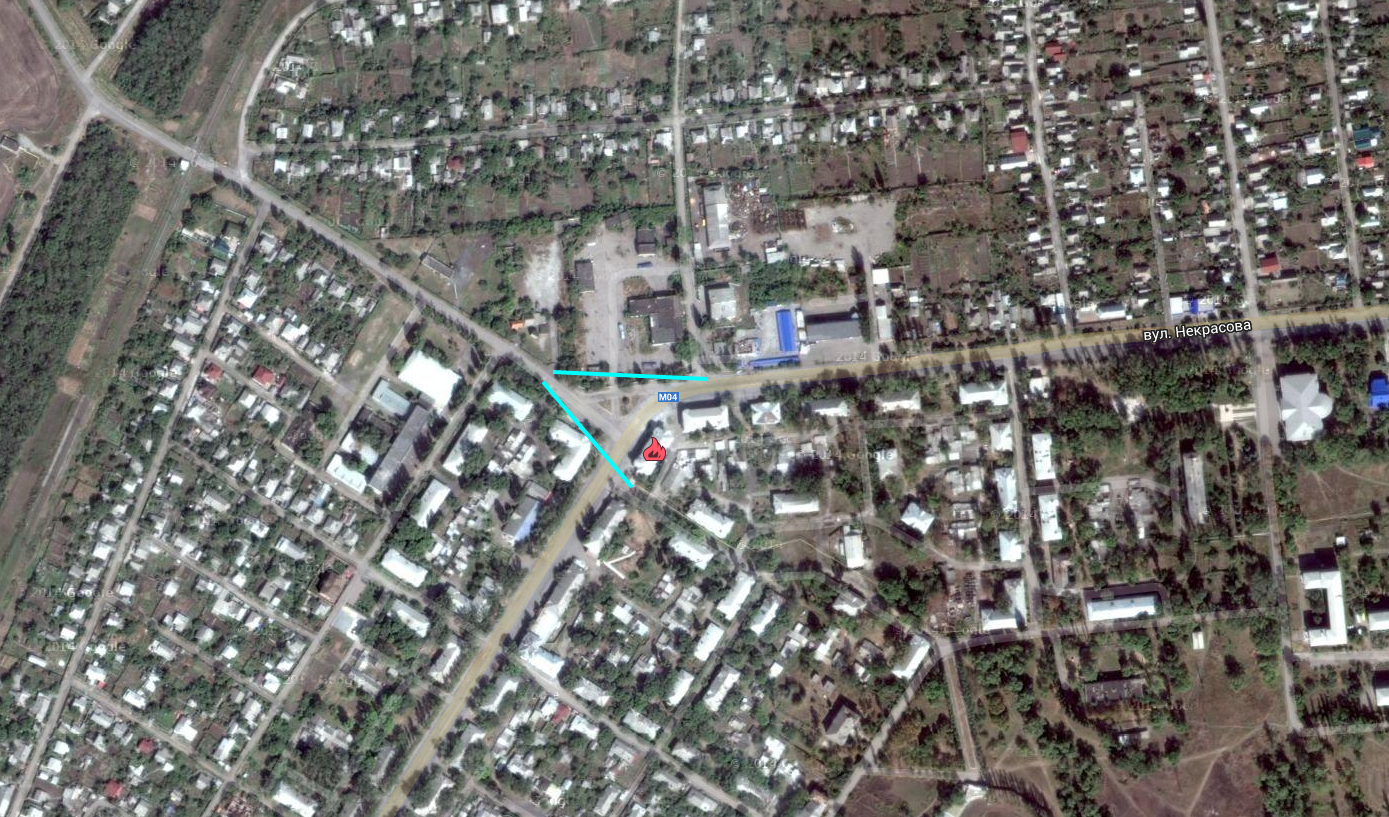
Zakharchenko told Rossiya-24 that “Today, we have sealed the Debaltsevo kettle,” referring to the encirclement of the Ukrainian foothold of Debaltsevo, to the east, which lies on the strategically important highway linking the separatist “capitals” of Donetsk and Lugansk.
But there was still some doubt that the Russian-backed separatist leader had made good on his claim.
Leonid Matyukhin, spokesman for the Ukrainian military’s ‘Anti-Terrorism Operation’ or ATO, told the BBC today that Ukrainian troops were not surrounded.

— Pierre Vaux
